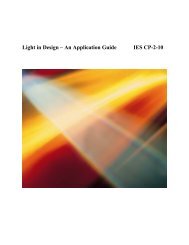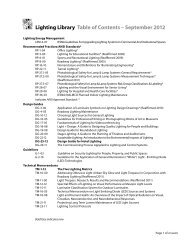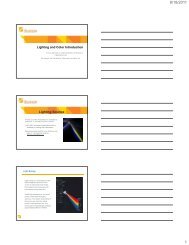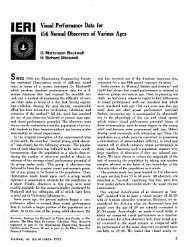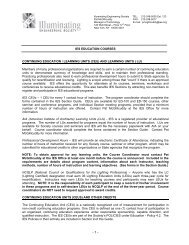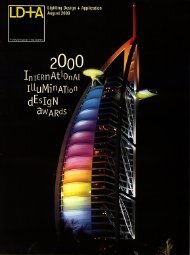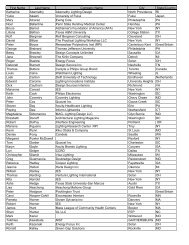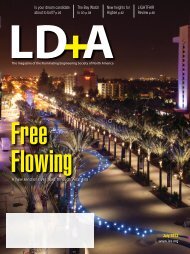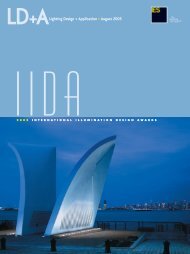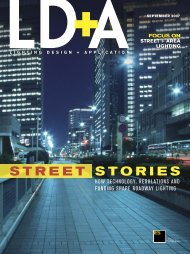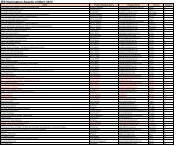light products - Illuminating Engineering Society
light products - Illuminating Engineering Society
light products - Illuminating Engineering Society
Create successful ePaper yourself
Turn your PDF publications into a flip-book with our unique Google optimized e-Paper software.
RESEARCH MATTERS<br />
Attending to Attention<br />
Yukio Akashi, Ph.D.<br />
Lighting Research<br />
Center, Rensselaer<br />
Polytechnic<br />
Institutete<br />
CAN GOOD LIGHTING HELP<br />
to reduce the number of traffic crashes<br />
A survey conducted in the U.S.<br />
reported that approximately 50 percent<br />
of crashes were related to drivers’<br />
improper attention (Treat et al.,<br />
1979).We are fortunate that research<br />
on attention flourished over the past<br />
three decades (Johnson and Proctor,<br />
2004). Findings from these studies<br />
may bridge the gap between <strong>light</strong>ing<br />
research and traffic safety.<br />
What Makes A Driver<br />
Inattentive<br />
Driving is a demanding, multitasking<br />
activity.A driver has to maintain a<br />
vehicle within a traffic lane while<br />
keeping its speed below (or at least<br />
not too far above) the limit, while following<br />
other vehicles (referred to as<br />
a “tracking task” in this column).<br />
Occasionally, a driver has to pass<br />
other vehicles and change lanes (a<br />
“changing task”).Talking on a cellular<br />
phone is an additional, but unrelated,<br />
task that increases the driver’s task<br />
load (a “distracting task”).<br />
On less frequent but more critical<br />
occasions, the driver must quickly<br />
detect oncoming traffic and obstacles<br />
such as torn tires on the pavement or<br />
deer on the shoulder, to avoid collisions<br />
with these potential hazards (a<br />
“detecting task”).<br />
As task load increases, a driver,<br />
who is already busy driving and talking<br />
on a cellular phone, can become<br />
distracted from such detection tasks.<br />
Inattention often originates from high<br />
task loads, and often results in missing<br />
targets and prolonged reaction times<br />
(Verwey, 1993), and even increased<br />
crash rates (Harms, 1986).<br />
How Does Task Load<br />
Affect Performance<br />
For each task described above, a<br />
driver must deal with a sequence of<br />
three distinctive information-processing<br />
stages: perceptional analysis (stimulus<br />
identification); response selection<br />
(decision-making);and motor response<br />
(response execution) (Pashler, 1998;<br />
Johnson and Proctor, 2004).<br />
As Figure 1 illustrates, these<br />
stages are often assumed to occur<br />
sequentially, so the results of one<br />
stage form the input to the next<br />
stage. Of these, response selection<br />
(decision-making) is the most<br />
demanding stage for the brain. This<br />
stage limits allocation of attention<br />
resources that can be shared with the<br />
other tasks, and it often appears to<br />
act as a bottleneck (Welford, 1952).<br />
To explore the mechanisms of<br />
dual-task performance, scientists use<br />
a sophisticated experimental technique.<br />
This technique has a subject<br />
respond to two individual stimuli, in<br />
which the time between the first and<br />
second stimulus varies in order to<br />
change task load.This method helped<br />
scientists conclude that the time it<br />
takes to respond to the second stimulus<br />
generally becomes longer (due<br />
to the period of slack in Figure 1)<br />
than when the second stimulus is presented<br />
alone or the task becomes<br />
more demanding (Vince, 1949).This is<br />
because the decision-making stage of<br />
the second stimulus cannot begin<br />
until the corresponding stage of the<br />
first stimulus has been completed<br />
(Pashler, 1998). However, scientists<br />
have also noted that the decisionmaking<br />
stage of the first stimulus can<br />
share attention resources with that of<br />
the second stimulus when both tasks<br />
are very difficult (Navon and Miller,<br />
2002). In these cases, a kind of interference<br />
occurs,and the decision-making<br />
of the first stimulus is often<br />
slowed down as well.<br />
How Can Good Lighting<br />
Improve Driving<br />
Performance<br />
The information processing framework<br />
described above allows us to<br />
understand the effect of good <strong>light</strong>ing<br />
F I G U R E 1<br />
Information processing framework (after Johnson and Proctor, 2004).<br />
on driving performance. To this end,<br />
this column reviews recent studies in<br />
which subjects performed detection<br />
tests (Task 2 in Figure 1) while<br />
engaged in simulated tracking and real<br />
driving tasks (Task 1). These studies<br />
compared performance under metal<br />
halide (MH) and high-pressure sodium<br />
(HPS) <strong>light</strong>ing at mesopic levels.<br />
To investigate the mechanisms of<br />
interference of <strong>light</strong>ing conditions<br />
with task load and performance, a<br />
study simulated a typical driving situation<br />
by combining three tasks: a<br />
tracking task, a distracting task and a<br />
detecting task (Akashi and Neches,<br />
2003). The tracking task required a<br />
subject to keep a needle in the center<br />
between a pair of thin horizontal lines<br />
by rotating a control knob. For the<br />
distracting task, the subject attempted<br />
to complete verbal mathematical<br />
(multiplication) problems as quickly<br />
as possible. The detecting task<br />
required subjects to signal immediately<br />
upon detecting one of eight target<br />
presentations.This study changed<br />
task load by changing combinations of<br />
the tracking and distracting tasks.<br />
Figure 2 depicts the results of<br />
these tests, which generally suggest<br />
the following: as task load increases,<br />
reaction time is increased; and target<br />
detection under MH was better than<br />
under HPS. These tendencies were<br />
confirmed by statistical analysis.<br />
Regarding interference, the tracking<br />
task appears to just add the same<br />
period of time to the baseline reaction<br />
times (in the detection-taskalone<br />
conditions) for both MH and<br />
HPS <strong>light</strong>ing. This suggests that the<br />
tracking task interferes little with the<br />
10 www.iesna.org



